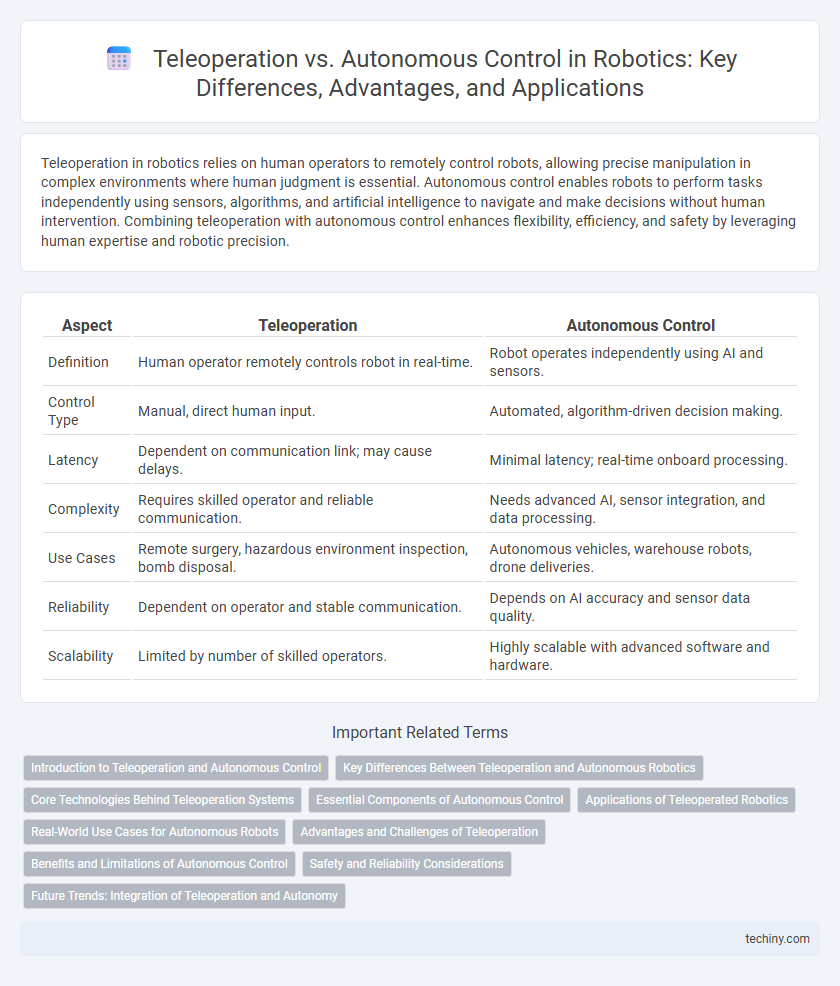Teleoperation in robotics relies on human operators to remotely control robots, allowing precise manipulation in complex environments where human judgment is essential. Autonomous control enables robots to perform tasks independently using sensors, algorithms, and artificial intelligence to navigate and make decisions without human intervention. Combining teleoperation with autonomous control enhances flexibility, efficiency, and safety by leveraging human expertise and robotic precision.
Table of Comparison
| Aspect | Teleoperation | Autonomous Control |
|---|---|---|
| Definition | Human operator remotely controls robot in real-time. | Robot operates independently using AI and sensors. |
| Control Type | Manual, direct human input. | Automated, algorithm-driven decision making. |
| Latency | Dependent on communication link; may cause delays. | Minimal latency; real-time onboard processing. |
| Complexity | Requires skilled operator and reliable communication. | Needs advanced AI, sensor integration, and data processing. |
| Use Cases | Remote surgery, hazardous environment inspection, bomb disposal. | Autonomous vehicles, warehouse robots, drone deliveries. |
| Reliability | Dependent on operator and stable communication. | Depends on AI accuracy and sensor data quality. |
| Scalability | Limited by number of skilled operators. | Highly scalable with advanced software and hardware. |
Introduction to Teleoperation and Autonomous Control
Teleoperation enables human operators to remotely control robots using real-time sensory feedback and control interfaces, ensuring precise maneuvering in complex environments. Autonomous control leverages advanced algorithms, sensors, and artificial intelligence to allow robots to perform tasks independently without human intervention. Understanding the differences between teleoperation and autonomous control is crucial for optimizing robotic applications in industries like manufacturing, healthcare, and exploration.
Key Differences Between Teleoperation and Autonomous Robotics
Teleoperation in robotics involves human operators remotely controlling robots, relying on real-time input and decision-making, while autonomous control enables robots to perform tasks independently using sensors, algorithms, and artificial intelligence. Teleoperated systems are ideal for complex environments requiring human judgment, whereas autonomous robots excel in repetitive or structured tasks with high efficiency. The key differences lie in human involvement, decision-making processes, and adaptability to dynamic or unpredictable conditions.
Core Technologies Behind Teleoperation Systems
Teleoperation systems utilize real-time communication technologies, advanced sensor integration, and haptic feedback mechanisms to enable remote robot control with high precision. Core technologies include low-latency wireless networks, computer vision for environmental mapping, and adaptive control algorithms that compensate for delays and ensure stable operation. These elements work together to provide seamless interaction between human operators and robotic systems, contrasting with autonomous control that relies on pre-programmed decision-making and AI-driven autonomy.
Essential Components of Autonomous Control
Autonomous control in robotics relies on essential components such as advanced sensors, real-time data processing units, and sophisticated algorithms for decision-making and path planning. These elements enable robots to perceive their environment, analyze inputs, and execute tasks without human intervention. Sensor fusion techniques and machine learning models are critical for improving accuracy and adaptability in dynamic conditions.
Applications of Teleoperated Robotics
Teleoperated robotics enables precise remote control in hazardous environments like deep-sea exploration, nuclear facility maintenance, and surgical procedures, where human presence is risky or impossible. By providing real-time feedback and fine motor control, teleoperation enhances safety and efficiency in disaster response and military operations. This technology bridges the gap between human intuition and robotic capability, expanding operational reach in complex, dynamic scenarios.
Real-World Use Cases for Autonomous Robots
Autonomous robots are widely deployed in industries such as manufacturing, agriculture, and logistics, where they perform tasks like assembly, crop monitoring, and inventory management with high efficiency and minimal human intervention. In hazardous environments like deep-sea exploration and disaster response, autonomous control allows robots to navigate and operate safely without continuous teleoperation, reducing risk to human operators. These real-world applications highlight autonomous robots' ability to adapt to dynamic conditions and execute complex tasks using advanced sensors and AI algorithms.
Advantages and Challenges of Teleoperation
Teleoperation enables precise human control of robots in complex or unpredictable environments, enhancing safety and decision-making in hazardous tasks like disaster response or underwater exploration. It faces challenges such as latency issues, limited bandwidth, and operator fatigue, which can impair real-time responsiveness and efficiency. Despite these challenges, teleoperation's adaptability and human oversight provide critical advantages where fully autonomous systems lack reliability.
Benefits and Limitations of Autonomous Control
Autonomous control in robotics enhances operational efficiency by enabling robots to perform tasks with minimal human intervention, improving precision and safety in hazardous environments. Limitations include challenges in adapting to unpredictable or dynamic scenarios and the high computational requirements for real-time decision-making. Advances in artificial intelligence and machine learning continue to mitigate these constraints, expanding the capabilities of autonomous robotic systems.
Safety and Reliability Considerations
Teleoperation in robotics offers enhanced human oversight, improving safety in unpredictable environments by allowing direct control and real-time decision-making, which reduces the risk of accidents caused by algorithmic errors. Autonomous control increases operational efficiency and consistency but demands robust fail-safe mechanisms and advanced sensor systems to reliably handle dynamic or hazardous settings without human intervention. Integrating hybrid systems that combine teleoperation with autonomous functions can optimize safety and reliability by leveraging human intuition and machine precision.
Future Trends: Integration of Teleoperation and Autonomy
Future trends in robotics highlight the seamless integration of teleoperation and autonomous control to enhance system flexibility and efficiency. Combining real-time human oversight with advanced AI algorithms enables adaptive decision-making in complex, dynamic environments. This hybrid approach promises to expand operational capabilities across sectors like hazardous material handling, remote surgery, and planetary exploration.
Teleoperation vs Autonomous control Infographic

 techiny.com
techiny.com